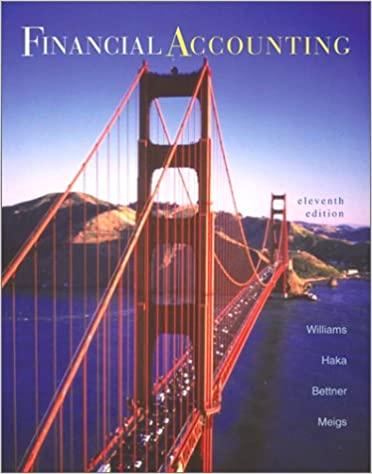1. The ease with which an asset can be converted into cash is termed a. financial flexibility b. Liquidity c. operating capability d. capital maintenance 2. To be recognized in the financial statements, an item must meet the definition of an element and be a. measurable, understandable, and relevant b. reliable, measurable, and realized c. realized, relevant, and reliable d. relevant, measurable, and reliable 3. Probable future sacrifices of economic benefits arising from past transactions or events are a. Liabilities b. Revenues c. Assets d. retained earnings 4. Which of the following assets is reported at its historical cost on the balance sheet? a. short-term investments b. merchandise inventory c. net accounts receivable d. prepaid insurance 5. The monetary value of the net assets contributed by the stockholders is called the a. physical capital b. excess capital c. net capital d. financial capital 6. Which of the following is not a characteristic of a liability a. It involves a responsibility to another company. b. The company has little or no discretion to avoid the future sacrifice. c. The sacrifice contributes directly or indirectly to the company's future cash inflows. d. The transaction obligating the company has already occurred. 7. The residual interest in a company's assets is represented by its a. net assets b. stockholders' equity c. ownership interest d. all of the above 8 The valuation method primarily used in the balance sheets of business entities is a current exit value b. historical cost c. present value d. net realizable value 9. The amount of cash (or equivalent) that would be required to obtain an asset shown on a balance she on the date of the balance sheet, is called the asset's a historical cost b. current cost c. current exit value d. present value 10. Which of the following is not a limitation of the balance sheet? a in periods of inflation, the amounts reported show the lack of purchasing power of the assets and liabilities b. failure to include all of a company's economic resources and obligations c. many of the amounts reported are based on estimates, which are subject to change d. valuing assets and liabilities using historical costs does not help in assessing a company's future cash flows a. one year 11. Current assets are cash or other assets that are reasonably expected to be converted into cash, sold, or consumed within b. one year or normal operating cycle, whichever is shorter c. one year or normal operating cycle, whichever is longer d. one normal operating cycle 12. Information: Long-term debt Retained earings Current assets Property, plant, and equipment Common stock Current liabilities Working capital amounts to a $150 b. S130 c. S120 d. S100 $40 30 150 60 130 50 13. Current liabilities would include all of the following except a wages payable b. obligations under capital lease contracts c. current portion of long-term debt d. uneamed rent revenue 14. Which of the following is typically recorded at its present value? a long-term investments b. long-term liabilities c. intangible assets d. contingent liabilities 15. How are gain contingencies reported in the financial statements? a. a contingent account receivable b. an accrued revenue c. a deferred revenue d not at all 16. The integrated disclosures required by the SEC for all regulated companies include all of the following except a dividends on common stock b. management's discussion c. common stock market prices d. book value of common shares BONO's 17. Which statement is true? a. Stock must have either a par or stated value. b. If nominal, par value does not need to be disclosed on the balance sheet. c. In most states, stock may be issued at more or less than par value. d. Par value does not suggest current fair value. 18. State law may require that capital stock have which of the following values? a.stated value b. market value c.no-par value d. present value 19. Which of the following would typically be recorded as an intangible asset? a computer software costs b. bond issue costs c. idle fixed assets d. prepaid pension costs










